page 1
~ The Study of Threes ~
http://threesology.org
Viewers as of 3/30/2021
| Threes in Physics page 1 | Threes in Physics page 2 | 3 (mem)brane Universe page 1 | 3 (mem)brane Universe page 2 | 3 (mem)brane Universe page 3 |
Before discussing the new 3-Brane Cyclic Universe Model, let's take a look at some general information for those who may not be particularly familiar with the Standard Universe Model, and then we'll review some arguments against it:
Here is a short review of the Standard Model: (Note it describes a "Hot" Big Bang and not a "Cold" one as one might think in terms of Cold Fusion.)
There was a big bang some 15 billion years ago, when the size of the universe was zero and the temperature was infinite. The universe then started expanding at near light speed.
The sequential events of this model are:
- Time t = 0 (about 15 billion years ago)
- Radius r = 0.
Temperature T = Infinite.
Density = mass per volume = Infinite. - t = 0.01 seconds
- T = 100,0.00,000,000 0C.
Energy is mostly radiation. - t = 2 seconds
- T = 10,000,000,000 0C.
Density = 100 million kg per cubic meter.
Proton-antiproton and neutron-antineutron pairs begin forming. - t = 3 minutes
- T = 1,000,000,000 0C.
Protons and neutrons begin forming hydrogen and helium. - t = 20 minutes
- About 25% of the protons and neutrons in the universe are now helium.
- t = 10,000 years
- T = 10,000 0C.
Density = 0.000,000,000,000,000,01 kg per cubic meter.
Most energy is now mass, not radiation.
Condensation into stars begins. A photograph from the Hubble space telescope of a birthplace of stars appears below. - t = 15 billion years (now)
- T = -270 0C. (This temperature is from the Penzias
and Wilson experiment described in the article.)
Density = 10-27 kg per cubic meter.
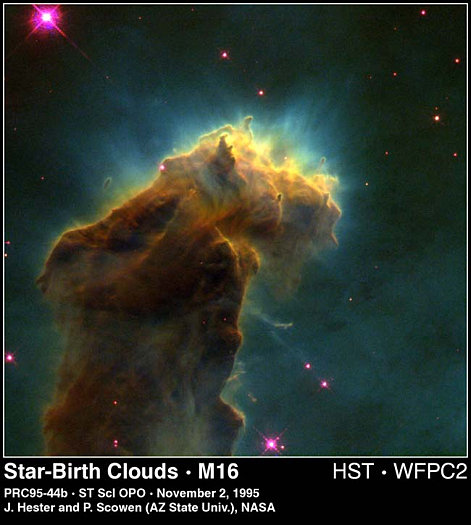
American nuclear physicist Steven Weinberg has proposed a theory of what the universe was like 1/100th of a second after its birth. Weinberg presents his theory to non-specialists in the book The First Three Minutes. He suggests that 1/100th of a second after its birth, the universe was characterized by super-high temperature (an absolute temperature of 100 billion degrees Kelvin) and super-high density. Into vast numbers of photons, neutrinos and electrons were mixed smaller numbers of protons and neutrons. After three minutes and 46 seconds, the temperature fell to 900 million degrees, and the fusion of the nuclei of helium and hydrogen atoms became stable. Subsequently, the universe cooled down over a long period and the gas that formed the galaxies came into being.
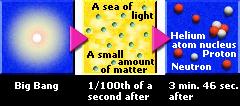
--- The First Three Minutes ---
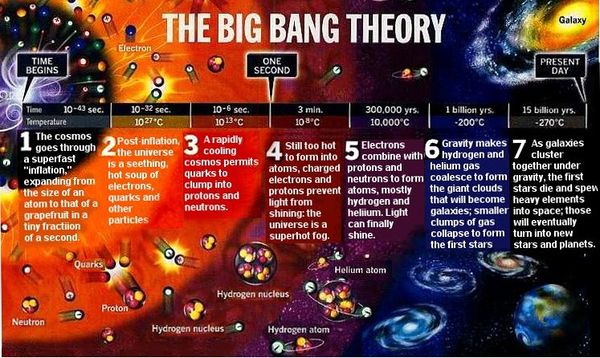
Pinterest Images
Here are some arguments against the Standard Universe Model:
For all its spectacular experimental successes, the Standard Model (SM) fails to give us solutions to such basic problems as:
- Why there are three copies (generations) of quarks and leptons.
- Why there are three different gauge forces (the Strong, Weak and Electromagnetic, with differing strengths).
- How gravity should be included in a consistent quantum theory along with the gauge forces.
http://www.cerncourier.com/main/article/40/10/19/1
The Standard Model of particle physics refers to the more commonly known 3-word description of The Big Bang, though it is known by other names as well such as the Inflationary Model, Standard Cosmological Model, Standard Universe Model, etc...

While the Standard Model provides a very good description of phenomena observed by experiments, it is still an incomplete theory. The problem is that the Standard Model can't explain why some particles exist as they do. For example, even though physicists knew the masses of all the quarks except for (the) top quark for many years, they were simply unable to accurately predict top's mass without experimental evidence because the Standard Model lacks a mathematical model for finding a pattern for particle masses.
Another question concerns the fact that there are 3
pairs of quarks and 3 pairs of leptons. Each "set" of these particles is
called a generation (a.k.a. family). Therefore, the up/down quarks are
first generation quarks, while the electron and e- neutrino are first generation
leptons. In the every-day world we observe only the first-generation
particles (electrons, e- neutrinos, and up/down quarks).
Why does the
natural world "need" the two other generations?
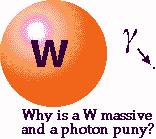
Another disturbing feature of the Standard Model is that many fundamental interactions simply aren't explained by the theory. For example, why is the W particle very massive and the photon massless, if both are force carriers? What causes the generation and distribution of particle mass? To explain this gap in the Standard Model theory, physicists have theorized the existence of a particle called the Higgs boson. This particle supposedly interacts with other particles in such a way that masses are generated in a proper fashion. The Higgs boson has not yet been observed, but physicists hope that future studies at high-energy colliders will prove or disprove its existence.
In principle, the Standard Model of the Universe can predict the outcome of any experiment (or the probabilities of the various possible outcomes), but in most cases of interest the theoretical calculations are too complicated to be carried out with current techniques. However, the model also has serious flaws:
- It does not account for gravity.
- Does not explain or predict the masses of the various particles.
- Requires a number of parameters (particle masses and the "KM-angles") to be measured and inserted into the theory.
To guide us in discovering a more complete theory we need to:
- Look for flaws in the present model by testing it with experiment.
- Measure the unknown parameters whose values should be predicted by a better theory.
- Look for new phenomena not predicted in the Standard Model.
Here is a 3 to 1 (3 items in 1 theory) representation that, like other things, can be filed under the rubric of "related" or "combination" just as are the three street-light colors "related" (combined) and three DNA/RNA codons "related" (combined) and so many other three-part subjects such as the three coins to one dollar "association" present in many vending machines, three fingers to hold/write with one pen or pencil, 3 membranes in 1 uterus, 3 (1st, 2nd, 3rd) molars in 1 set of teeth, 3 main/large (neutrons- protons- electrons) sub-atomic particles to 1 atom, 3 and 1 phase electric service in the United States, 3 school grading degrees (A+ A A-), 3 in 1 sentence ending punctuations (period- question mark- exclamation point), etc...:
The Standard model of particle physics has three "related" natural near-symmetries. These state that the actual universe about us is indistinguishable from one where:
- Every particle is replaced with its anti-particle. This is C-symmetry (Charge symmetry);
- Everything appears as if reflected in a mirror. This is P-symmetry (Parity symmetry);
- The direction of time is reversed. This is T-symmetry (Time symmetry)
These symmetries are near-symmetries because each is broken in the present-day universe. However, the Standard Model predicts that the combination of the three (that is, the simultaneous application of all three transformations) must be a symmetry, called CPT symmetry. CP violation, the violation of the "combination" of C- and P-symmetry, is necessary for the presence of significant amounts of baryonic matter in the universe. CP violation is a fruitful area of current research in particle physics.
This link directs you to a larger collection of 3 to/in/with 1 examples:
Additional pages may be accessed through this link:
--- Contents page 5 ---|
Perhaps a better physics Model requires the adoption of a Threesological perspective in the sense of also addressing the issue of why there is a repeating "three" theme in the models and contents. If we are environmentally influenced to be genetically predisposed to conceptualize many of our ideas, perform many of our activities and grow physiologically along a 1- 2- 3 maturational development sequence; understanding the Universe through the tools of physics may require to identify that which is influencing the design of the tool in the first place. It would appear that physics has adopted the design of particular tools and expects the nuts and bolts to fit the tools. Perhaps physicists are using too large a pipe wrench to open a valve (of knowledge) that is best opened with a smaller crescent wrench or pair of pliers. All metaphor aside, we must ask if a recurring "threes" theme found amongst particles, etc., is the actual form (and function) of matter, or do we only see (theorize) it as such because we have been and are still influenced to see things this way... due to an underlying "threes" influencing component such as DNA's triplet codon system which may have been designed by an identifiable (but socially unrecognized) three-patterned environmental event taking place during our biological development as a (Primordial Soup) organism now called (the human) species?...H.O.B. |
The 3 (mem)-Brane Universe refers to the 3 dimensional world we live. Aligned with this label is a new idea about the Standard Big Bang Model concerning the origin of the Universe. In short, the new model suggests that the Big Bang which is thought to have created our Universe is not "THE" first and only event, but is one of many Big Bang sequences which occur in a repeating fashion of:

The foregoing image reminds me of someone breathing though before putting the animation together I was thinking in terms of an expanding and collapsing balloon. Perhaps the action of our lungs, like the wax and wane of the ocean tides, is a re-creation, in miniature, of an event that took place billions of years ago but nonetheless made an indelible mark on things that followed.
The new idea, called the Ekpyrotic Model of the Universe (ek-pyr-o-sis [Greek]: Conflagration), was initially developed by the efforts of Princeton physicist Paul Steinhardt and Neil Turok of Cambridge University who described their proposed theory in an article published April 25 in an online edition of Science.
The theory proposes that, in each cycle, the universe refills with hot, dense matter and radiation, which begins a period of expansion and cooling like the one of the standard big bang picture. After 14 billion years, the expansion of the universe accelerates, as astronomers have recently observed. After trillions of years, the matter and radiation are almost completely dissipated and the expansion stalls. An energy field that pervades the universe then creates new matter and radiation, which restarts the cycle.
article by Steven Schultz
Yet, why does the so-called Big Bang repeat? Is this idea of repetition due to the influence of Earth's cyclical seasons that we have merely applied to a cosmological consideration? Why have a cyclical repetition at all? Why is existence the way it is? So we can have a human civilization and all its many Business, Political and Religious activities of nonsense? Heaven forbid if present humanity is the ultimate expression of existence. Humanity must get off of this planet in order to intentionally subject it to an environment that will influence the adoption of better ideas. We don't have to live on a planet. Perhaps living on a large space station would be more conducive to the development of greater knowledge. Then again, humanity will have begun the trek towards becoming a different "Homonoid" species. ...H.O.B.
..."In the standard picture, it's presumed that the Big Bang is actually a beginning of space and time; that there was nothingness, and then suddenly out of nothingness there sprang space, time, matter, radiation, et cetera.
...in this new picture the Big Bang is not a beginning of time but really just the latest in an infinite series of cycles, in which the Universe has gone through periods of heating, expanding, cooling, stagnating, emptying, and then re-expanding again."
article by Cosmology writer Marcus Chown
The so-called cosmological "pictures" are not only being drawn and taken from the same (Earthly) vantage point, but also subjected to the same processes of development. In short, physicists of today are little more than the daguerreotypists of yesteryear, and the public, for the most part, are so enthralled about the simplistic images being presented, society as a whole remains in a collective state of naïveté. ...H.O.B.
A Brief Introduction to the Cyclic Universe
Paul J. Steinhardt
...a new paradigm has been recently proposed by Paul Steinhardt (Princeton) and Neil Turok (Cambridge) - the cyclic universe - that turns the conventional picture topsy-turvy. (Perhaps the model should be called an old paradigm since it reinvigorates ancient cosmic mythologies and philosophies, albeit using the tools of 21st century physics.) In this picture, space and time exist forever. The big bang is not the beginning of time. Rather, it is a bridge to a pre-existing contracting era. The Universe undergoes an endless sequence of cycles in which it contracts in a big crunch and re-emerges in an expanding big bang, with trillions of years of evolution in between. The temperature and density of the universe do not become infinite at any point in the cycle; indeed, they never exceed a finite bound (about a trillion trillion degrees). No inflation has taken place since the big bang. The current homogeneity and flatness were created by events that occurred before the most recent big bang. The seeds for galaxy formation were created by instabilities arising as the Universe was collapsing towards a big crunch, prior to our big bang.
The prospects for an alternative cosmology that is so different from the well-established convention would seem extremely dim. Yet, the cyclic model recoups all of the successful predictions of the big bang/inflationary theory and has sufficient additional predictive power to address many questions which the big bang/inflationary model does not address at all:
- What occurred at the initial singularity?
- What is the ultimate fate of the Universe?
- What is the role of dark energy and the recently observed cosmic acceleration?
- Does time, and the arrow of time, exist before the big bang? or after the big crunch?
Sweet Deal or Swindle?
Jim Richardson and Allen Richardson
"Perhaps the [recently proposed Cyclic Universe] model should be called an old paradigm since it reinvigorates ancient cosmic mythologies and philosophies…"
The plain fact of the matter is, Steinhardt's description of his "Cyclic Universe" is a dead ringer for another theory, the QSSC (Quasi Steady State Cosmology), which has received exactly no credit from Steinhardt. We might imagine that Steinhardt would acknowledge this similarity in his paper. But Steinhardt opted to say nothing. Steinhardt would have us cast our memories waaaaaaay back to "ancient cosmologies and philosophies," and yet he would have us totally forget about the QSSC, which is not even two decades old.
We emailed Geoffrey Burbidge, one of the co-authors of the QSSC, to ask what he thought of the Cyclic Universe theory and its rather obvious similarity to his own. He emailed back, saying with barely disguised distaste: "Apparently the Steinhardt-Turok theory has some similarities to the quasi-steady state theory." But he also wished to remind us of the stark difference between the two: "Of course the major difference is that we believe that the creation process and the generation of new galaxies takes place in the nuclei of existing galaxies and is going on all around us. This is an old idea of Ambartsumian and there is lots of observational evidence in favor of it which is discussed in our book A Different Approach to Cosmology."
Burbidge's point is that even though the Steinhardt-Turok theory of the Cyclic Universe has a cosmetic similarity to the QSSC, it remains a mere Big Bang variant. The Cyclic Universe theory does continue after all to accept the Big Bang's unruly window-dressing like Dark Energy, Dark Matter, Quintessence, etc.; in fact it IS the Big Bang theory with everything intact except a beginning of time and space. Burbidge, a long-time Big Bang detractor, likely finds it execrable for Steinhardt and Turok to accept so many Big Bang premises, which he and his famous/infamous colleagues have debunked for so long.
Some readers will wonder why one theory gets wide-spread news coverage, while another one doesn't. And for that matter, when does an idea really become new and different? If we use the analogy of building an automobile, what do we call an automobile that uses a Chevy engine, ford drive-train, a Dodge chassis, and a Volkswagen body? Do we call it a traditional name or make up a new one, even though our design uses parts from different manufacturers? Likewise, if a theory of the Universe uses material from other ideas, is it an old idea with a new suit of clothes, or a new idea with an old suit of clothes? Such perceptions determine whether or not an idea either fuels the imaginations of the public and news media whereby it gets enormous attention, or it can be barely reacted to... perhaps due to the public's and media's inability to appreciate the information on the one hand, and over-value it on another.
Clearly, the new Cyclic Universe Model is an expanded form of the Standard Big Bang Model, but it still does not provide us with understanding how, why and when the very first so-called Big Bang event began, and for how long the cyclic motion will continue. The cyclic model appears to be an idea quite reminiscent of those views involving a perpetual motion machine. And as for the idea of counting more and more dimensions as a means to explain atomic behavior that can not be explained by current (mathematically intensive) Cosmological Models, we should consider the possibility that a new brand of phrenology is being practiced. Whereby, in an attempt to explain particular behaviors of humans, phrenologists of old would simply look for more bumps on a person's head. The size, shape and placement of bumps on a person's head would be used to explain particular anomalous behavior that was not explained adequately by other prevailing ideas of the time. Then again, we could also interpret the recurring habit of some mathematicians to explain particular atomic effects by adding more and more dimensions, a type of numerology akin to the activity of those who manipulate the numbers on their tax returns in an attempt to not have to pay (exceptionally) high taxes, and or get a better tax refund.
Let's take another look at the New Cyclic "Big Bang" Model:
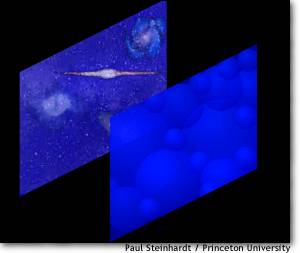 |
In the cyclic model, our three-dimensional universe is one of two surfaces, or "branes," separated by an extra dimension. The two branes bounce off each other to give rise to matter and radiation, and then expand and dissipate due to dark energy. Instead of one Big Bang, a succession of bangs could be sparked when rippling waves of space-time crash into each other in extra dimensions. This scenario — dubbed the "ekpyrotic model," which plays off the Greek word for "conflagration" — was put forward as the best rival to the mainstream model. |
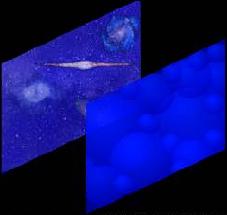 |
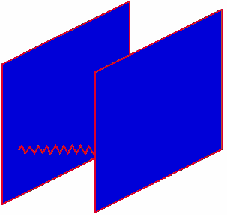 |
| Gauge forces and matter confined to live on coincident branes arise from open strings with end-points on the branes. | |

...According to the Cyclic Model theory, our three-dimensional Universe, known as a "3-brane" to cosmologists, is just one of the two boundary surfaces of a thin four-dimensional "bulk space," rather like one of the two surfaces of a CD. But there was another universe, or bulk brane, inside the bulk space which encroached on our boundary brane. When this "brane storm" led to a collision, the energy released resulted in the big bang. Unlike inflation, the brane-storm model -- dubbed the "ekpyrotic universe" by the authors of the paper, related to the Greek idea of "cosmic fire" -- fits in neatly with the popular string theory of particle physics.

The idea of brane-filled Universes inter-spaced by string theory brings many images to mind. One of which is the old wooden paddle-ball toy in which a ball, connected to a (string of) rubber band, is repeatedly bounced to and from the surface of a wooden paddle. However, what also comes to mind is a pancake being flipped in a red hot frying pan or a slinky (toy), or an accordion....
In the above (to-the-left) image, I have tried to elaborate, with some artistic license the brane Universe "bounce." ("Artistic license" is the adult means of saying the expression of a creative child when they announce "I can do anything I want to.")
With respect to an accordion, I guess we can call this the music of the spheres, or music of the planes, (or noise of the neighborhood kids pretending to be a musical rock group in a garage that is not sound-proof.)
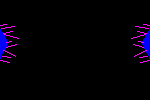
Yet, by looking at the "colliding" brane images on this page, it may give some readers the impression that one of the branes is kept stationary, while another one (or more) is the aggressor, like someone throwing a ball against a (stationary) wall (even though the wall is moving in terms of the Earth's motions). With such said, we must ask whether or not one (or more) of the mem-branes is always (sometimes?) stationary, or all they all dynamic (moving)? The image to the right exhibits both branes moving towards one another, though we could just as easily conceal the two "outer" branes and only show the "invisible" central dimension. Then again, we could try a sort of (toy) slinky version of the colliding Branes:

Perhaps we should consider the possibility that branes can (and sometimes do?) "bounce" in (all?) three different directions as is illustrated in the following image:

Image source:
However, there are some viewers who might venture to see the slinky as symbolic of DNA strands, with the strands symbolically representing string theory. And other readers will not visually turn the images in different directions whereby the vertical and diagonal positions (along with there corresponding labels such as up/down, etc.) are not considered. For the philosophically minded reader, it is of value to alternate the labels and intellectually configure the appropriate medium in which such an event might occur.
In thinking about the string theory which attempts to explain the relationship of the three fundamental gauge forces (Strong- Weak- Electromagnetic) and the one fundamental non-gauge force (gravity), this 3 to 1 ratio of "vibrating" strings reminds me of the "vibrating" hair cells in the human ear. In the ear we find 3 rows of outer hair cells and 1 row of inner hair cells. Perhaps the so-called strings have a similar configuration in terms of alignment in "rows." Hence, the "white noise" of the Universe is but an internal sound that an audiologist would call a self-generated form of tinnitus.
Are the so-called "strings" linear in one dimension, circular in another dimension, and triangular-like in a third dimension? Thus, gravity can be considered a composite of the three just like quaternary proteins are a composite of the single- dual- triple protein strands.
Coincidentally, while we speak of space "ships" for vessels which transverse the vastness of the cosmos, but don't characteristically label outer-space as an ocean, the aforementioned slinky model is highly reminiscent of the following model used in describing longitudinal ocean waves. But please note that I came up with the slinky model quite independently... as an image recalled from childhood while putting this page's information together.

--- Multimedia Physics Studios ---
Now compare this with the action of a photon in a vacuum (propagation of an electromagnetic wave):
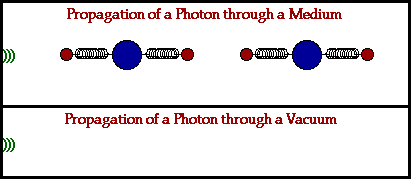
--- Multimedia Physics Studios ---

As an aside note, for those readers who appreciate divergent comparisons related to an expansive model of correlations, we find linear, circular, triangular wave forms, though other labels for waves are given such as wind waves, swell, longitudinal, transverse, etc... The image to the right shows three basic types of waves. The presence of these three forms can be found elsewhere as well:
The following list of Linear - Circular - Triangular examples is for those who can easily visualize the printed word:
| "3" Basics Formula | |||
| 3 galaxy/universe items | Our galaxy through space | Motion of galaxy | Expansion/Contraction{<>,X} |
| 3 basic Earth motions | Earth+Moon+Sun | Rotation of Earth | Precession of Earth's axis |
| 3 forms of matter | Liquid | Solid | Gas |
| 3 fundamental forces | (N)electro-magnetism(S) | Gravity | Nuclear (+)(-)(+/-) |
| 3 conceptual models | Primitive NSEW | Native American | Indo-European |
| 3 (hair) cross-sections | African: ribbon-like | Asian: circular | Caucasian: ellipsoid |
| 3 Earth shapes | Earth is flat | Earth is round | Earth is a triaxial ellipsoid |
| 3 Universe theories | Universe is flat | Spherical | Saddle (triangular)-shaped |
| 3 stone tool shapes | Mono-facial | Bi-facial | Tri-facial (arrow heads) |
| 3 engineering tools | Lever | Pulley/Wheel | Fulcrum |
| 3 engine shapes | In-line, Slanted, etc... | Radial, Rotary | V-shaped |
| 3 shapes game | Paper | Rock | Scissors |
| 3 human face items | Eyebrows | Eyes | Nose |
| 3 playground items | Monkey bars/See-saw | Merry-go-round | Slide/Swing-set support |
| 3 in-vehicle views | Road, Stick shift, etc... | Steering wheel | Perceptual view of distance |
| 3 early industry tools | Staff, Poker | Pottery wheel, Kiln | Fire (flame), Bellows |
| 3 pre-industry tools | Stick | Rock | Fire (flame) |
| 3 cyanobacteria shapes | Filamentous (string-like) | Coccoidal (ball-like) | Ellipsoidal (egg-shaped) |
| 3 stromatolite shapes | Flat-layered | Domical/Columnar | Conical |
| 3 building structures | Skyscrapers | Coliseums Stadiums,etc. |
Pyramids |
| 3 foot descriptions | Heal to Toe line | Balls of feet | Arch of foot |
| 3-in-1 necktie forms | Frontspiece covers buttons | Encircles the neck | Triangle slip knot |
| 3 bird-flight formations | Diagonal, Horiz., Vertical | "Bunched up" | V-shaped (also J/L/7 variations) |
Note: I used the symbols {><} and {X} to portray expansion and contraction. Did the Universe expand like a bursting ball in all directions or a selected direction? It is not certain if the "Big Bang" occurred at a single point and then expanded in all directions. Unless we care to consider that our Universe is the result of an implosion, which is 1 idea, then there are 3 other theories we can consider, which brings our overall formula to a 3:1 ratio. The other three being a Linear- Circular- Triangular expansion after the Big Bang. Also, if the expansion is slowing down, is there to be an eventual "Big Crunch?"
In a multi-dimensional model of "Brane Bouncing" (collision):
| Making an Ekpyrotic Universe |
||||
| A membrane with strange physics bounds one end of the fifth dimension. | Þ |  |
Ü | A membrane that is destined to become our universe bounds the other end. When one slams into "our" membrane the universe we now live in is born. |
the fifth dimension. |
||||
Image and information adapted from:
The discussions of 3 mem-branes related to a Model of the Universe brings to mind various biologically-related images. One such notion is that models of the Universe are actually condensed, abbreviated and abstracted simplistic references to the conception, birthing and maturation of a life form. When I see triangle-shaped "cut-out" portrayals of the Big Bang Universe, I get the impression of looking at a type of triangular-shaped sonogram (ultrasound) image of a developing infant. Imagine if the birth of every infant is but a symbolic microcosmic replication of events taking place in the macro-cosmos (hence the notions of embryonic Galaxies, baby Universes, adolescent solar systems, etc...):
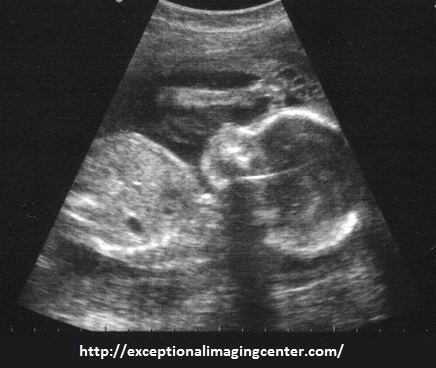 Sonogram of a developing human fetus | |
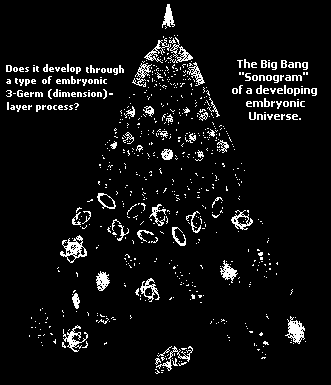
--- Grand Unification and Super-symmetry --- |
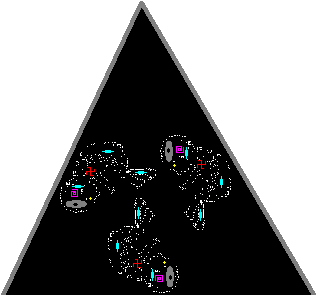
A triplet dimension Universe |
On the next page, let us explore the 3 Brane Cyclic Big Bang model by using a few different analogies...
Links that may be of some interest:
--- The Physics Classroom: Waves and energy transport ---
Page initially created (approx.): Friday, 10th May 2013, 6:30 AM
Page updated: Tuesday, 29th-May-2018... 12:39 PM
Newest update: Tuesday, 30th March, 2021... 1:22 PM
Herb O. Buckland
herbobuckland@hotmail.com